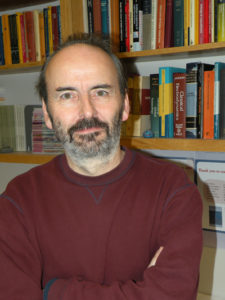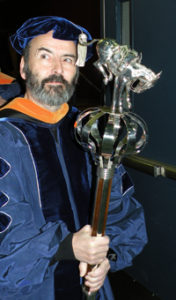2011 Distinguished Lecture Series: Paul A. Martin
What is Applied Mathematics, Really? And Why Might You Need It, Really?
Biography
 Paul A. Martin is a Londoner. He joined Mines in 1999 as Professor of Mathematical and Computer Sciences and is currently Professor in the Department of Applied Mathematics and Statistics.
Paul A. Martin is a Londoner. He joined Mines in 1999 as Professor of Mathematical and Computer Sciences and is currently Professor in the Department of Applied Mathematics and Statistics.
He holds a BSc in Mathematics from the University of Bristol, and two degrees from the University of Manchester: MSc in Applied Mathematics and Fluid Dynamics, and PhD in Mathematics.
Before moving to Mines, he held several positions at the University of Manchester. He took one-year sabbaticals at the University of Delaware (1986-87) and at Mines (1995-96), both supported by Fulbright awards. He also spent the first half of 2007 in Paris, where he worked at three different institutions.
He has published more than 110 journal papers and is the author of a book on “Multiple Scattering”, published by Cambridge University Press in 2006.
Dr. Martin is an editor of three journals, the SIAM Journal on Applied Mathematics, the Quarterly Journal of Mechanics and Applied
Mathematics, and the Journal of Integral Equations and Applications. He is also an editor of the forthcoming Princeton Companion to Applied Mathematics.
Like many applied mathematicians, Dr. Martin’s research covers a broad range of topics, often problem-driven. Common themes are waves (acoustics, hydrodynamics, electromagnetics, elastodynamics) and how they interact with objects, continuum mechanics, and related mathematical techniques (especially integral equations and asymptotics). He likes to work on new problems, often in collaboration with engineers and scientists. For example, he has collaborated for many years with Dr. John Berger in the Department of Mechanical Engineering on a variety of problems in mechanics.
Paul and his wife Ann have been married for 32 years, after meeting in a student bar at Manchester University. They have three children, including two Mines graduates (Frances and Richard) and a baby (Ruth) who is currently a PhD student in Boulder.
Abstract
 What is applied mathematics, really? And why might you need it, really?
What is applied mathematics, really? And why might you need it, really?
The first question recalls the title of a book by Reuben Hersh, “What is mathematics, really?”, a book about the philosophy of mathematics. Here, the extra word “applied” suggests pragmatism: of course, we do not consider fanciful notions at Mines.
Next, every Mines student gets a healthy dose of calculus, and most Mines faculty probably feel they (the faculty, if not the students) have enough mathematics in their research toolboxes. And this brings us to the second question.
But first, what is applied mathematics?
One definition: new mathematics intended to solve problems that have come from science or engineering. It is not merely solving such problems using existing mathematics — although applied mathematicians do that too, especially on a campus like Mines.
Applied mathematics is a distinct discipline. As George Batchelor wrote in 1952 (not long before founding the Journal of Fluid Mechanics), applied mathematics “is a science in its own right, and is neither a watered-down version of pure mathematics nor a prim form of physics.”
Mathematics emerged in ancient times so as to treat practical problems, with pure mathematics coming later. Thus, one could say applied mathematics came first!
Its history over the last century is interesting, and it is quite different in Europe and the U.S.
In effect, there was almost no applied mathematics in the U.S. before World War II, while new mathematics was being developed in Europe to help understand contemporary problems in physics and engineering.
In the U.S., applied mathematics continued to be perceived as “a watered-down version of pure mathematics” in university mathematics departments for decades. We shall describe some of this history and the current state of affairs.
The skills and expertise of applied mathematicians make them invaluable. In my opinion, one high-level reason is that, when asked a question, they do not really care what the answer is, only how to get it: if you like, they have no agenda. The benefits of this carefree attitude will be developed in the lecture.
And then, you might feel convinced that you do need an applied mathematician. Really.
